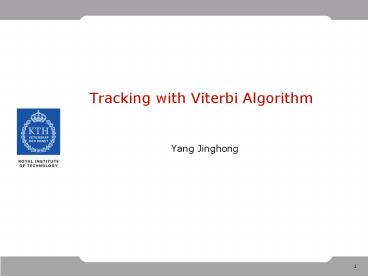Tracking with Viterbi Algorithm - PowerPoint PPT Presentation
1 / 13
Title:
Tracking with Viterbi Algorithm
Description:
t = 1 t = 2 t = 3. 5. Viterbi Tracking (Discrete state space) Methodology: trellis diagram. Quantize continuous states. 6. Initial and Ending States ... – PowerPoint PPT presentation
Number of Views:215
Avg rating:3.0/5.0
Title: Tracking with Viterbi Algorithm
1
Tracking with Viterbi Algorithm
- Yang Jinghong
2
Viterbi Algorithm
- Apply to discrete time, memoryless systems
- Observed in memoryless noise
- Optimal in the sense of minimizing error
probability.
3
Viterbi Tracking (Continuous state space)
4
Viterbi Tracking (Continuous state space)
t 1 t 2 t 3
5
Viterbi Tracking (Discrete state space)
- Quantize continuous states
- Methodology trellis diagram
6
Initial and Ending States
- Knowledge of initial state is not crucial
- Ending state
- - Optimal estimates if ending state is known
- - If allow sufficient long delay, estimates can
approach optimal.
7
Pros and Cons
- Pros
- No requirements for linearility on process and
observation models - Cons
- - Transition probabilities, and observations
dependency on state should be attainable.
8
Comparations with Kalman Filter
- Kalman filter
- Extended Kalman Filter
- Viterbi Algorithm
9
Example
10
Thank You !
11
Reference
- 1 The Viterbi Algorithm, G. DAVID FORNEY, JR.
1973 - 2 Manoeuvring-target tracking with the Viterbi
algorithm in the presence of interference, Kerim
Demirbag, 1989 - 3 Comparison of Kalman Filter Estimation
Approaches for State Space Models with Nonlinear
Measurements, Fredrik Orderud
12
Kalman Filter
- Linear dynamic systems
- (wide-Sense) Markov chain
- Additive, white, Gaussian noise
- Continuous state space
13
Extended Kalman Filter (EKF)
- Non-linear dynamic systems
- (wide-Sense) Markov chain
- (Additive) Gaussian noise
- Continuous state space
- Notes.
- Linearization First order Taylor approximation
- Diverge over time (unstable)































